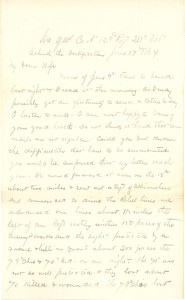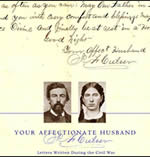 [google-map-v3 width=”400″ height=”300″ zoom=”12″ maptype=”hybrid” mapalign=”right” directionhint=”false” language=”default” poweredby=”false” maptypecontrol=”false” pancontrol=”false” zoomcontrol=”true” scalecontrol=”false” streetviewcontrol=”false” scrollwheelcontrol=”false” addmarkermashupbubble=”false” addmarkerlist=”34.023405; -84.616764{}1-default.png” bubbleautopan=”true” showbike=”false” showtraffic=”false” showpanoramio=”false”]
[google-map-v3 width=”400″ height=”300″ zoom=”12″ maptype=”hybrid” mapalign=”right” directionhint=”false” language=”default” poweredby=”false” maptypecontrol=”false” pancontrol=”false” zoomcontrol=”true” scalecontrol=”false” streetviewcontrol=”false” scrollwheelcontrol=”false” addmarkermashupbubble=”false” addmarkerlist=”34.023405; -84.616764{}1-default.png” bubbleautopan=”true” showbike=”false” showtraffic=”false” showpanoramio=”false”]
Hd. Qurs. Co. “A” 129th Regt. Ills. Vols.
Behind the Fortifications, June 17th 1864
My Dear Wife
Yours of June 9th came to hand last night, & I read it this morning.1 As I may possibly get an opportunity to send a letter to-day, I hasten to write.
I am most happy to learn of your good health. Do not think it hard that our mails are not regular. Could you but know the difficulties that have to be surmounted, you would be surprised that any letters reach you.
We moved forward at noon on the 15th about two miles, & sent out a Regt. of skirmishers and commenced to drive the Rebel lines. We advanced our lines about 1-1/2 miles, the left of our Regt. resting within 150 paces of the Enemy’s works and the right protected by a ravine & hill in front about 200 paces, the 79th Ohio & 70th Ind. on our right.2 The 70th [Ind.] was not so well protected, & they lost about 70 killed & wounded. The 79th Ohio lost about 40, & our loss was about 20.3 I did not learn the loss in the 102nd & 105th [Illinois], but it was not heavy.4 Our Division has lost heavily again. The loss in our Regt. was all on the left: Henry Hornder of Co. “G” killed; Hoffman, Co. “B” killed & Stahl, Co. “B” mortally wounded; & Sergt. Deborn, Co. “K” killed.5 A few of the wounded are serious but most of them slight. I have not learned all their names. Col. [F. C] Smith, 102nd Ills., slightly wounded; Major [Z. S.] Reagan, 70th Ind., severely.
We fortified all night on the 15th & all day yesterday. We were ready for a hard fight to-day, but last night the enemy withdrew, how far no one knows, but their rear guard throws solid shot nearly to our lines.6 Our skirmishers are 1-1/2 miles in advance.
The Lord has again signally cared for us. On the evening of the 15th, the shot & shell fell all around us in torrents. The bursting of the shell was close enough to burn the faces of the men, & yet none were hurt. Let us thank God for his mercies. We are all well, & will probably advance this morning. There is heavy cannonading on our left in the direction of Marietta and the river. Alf [Huetson] has just come, & I will close & send by him. May God bless you. Give my love to all. Good bye.
Your Affect. Husband
J. F. Culver
- Mary Culver’s letter of June 9 is missing from the Culver Collection. [↩]
- On the 14th, with a cessation of the rain, Sherman ordered his army commanders to advance skirmish lines and crowd the enemy, but not to assault them in their fortifications unless “some specially favorable opportunity should occur.” Thomas pushed forward the right of Palmer’s corps and the left of Howard’s into the re-entrant angle between Pine Mountain and the Confederate works to the east. Next day, the Rebels having evacuated Pine Mountain, Thomas sent Hooker’s corps forward. Butterfield’s division was deployed into the line of battle at Gilgal Church, forming east of the Sandtown road. Covered by a strong skirmish line, General Ward advanced his brigade, took possession of two hills to his front, and thrust into the woods beyond, driving pickets and sharpshooters from Cleburne’s division before him. Ward was now ordered to attack and hurl the Confederates from the breastworks pinpointed by his scouts 600 yards to his front. The bluecoats surged forward with fixed bayonets and dislodged the Rebels from their advance line of rifle pits, but were unable to carry their main line of works. O. R., Ser. I, Vol. XXXVIII, pt. II, pp. 324-325, 367. [↩]
- In this fight, known as the battle of Gilgal Church, the 70th Indiana lost three killed and 46 wounded; the 79th Ohio 16 wounded; and the 129th Illinois three killed and 15 wounded. Ibid., pp. 367, 374, 377. [↩]
- The 102d Illinois lost 13 wounded and the 105th Illinois had seven killed, 40 wounded, and one missing in the action of June 15. Ibid., pp. 355, 361. [↩]
- Henry K. Handler enlisted in Company G, 129th Illinois Infantry, on Sept. 22, 1862, as a private. He was killed near Kennesaw Mountain on June 15, 1864. Compiled Service Records of Union Soldiers, NA. William Hoffman, a 23-year-old farmer, was mustered into service on Sept. 8, 1862, as a private in Company B, 129th Illinois Infantry. He was killed in action near Kennesaw Mountain, Ga., June 15,1864. August Stahl, a 26-year-old farmer, was mustered into service on Sept. 8, 1862, as a private in Company B, 129th Illinois Infantry. Wounded near Kennesaw Mountain on June 15,1864, Private Stahl died in a military hospital at Resaca, Ga., five days later. Henry F. Dibbern, a 29-year-old millwright, was mustered into service on Sept. 8, 1862, as a corporal in Company K, 129th Illinois Infantry. He was promoted to sergeant on May 13, 1863, and was wounded in the arm on June 15, 1864, dying the next day in a field hospital at Burnt Hickory, Ga. [↩]
- The Confederates’ left (Hardee’s corps) found its position untenable, and on the night of the 16th abandoned its position and retired into a new line of earthworks behind Mud Creek, three miles to the east. Schofield and Thomas followed Hardee, their skirmishers clashing frequently with Rebel cavalry seeking to slow their advance. Cox, Atlanta, p. 100. [↩]

 Subscribe via RSS
Subscribe via RSS Subscribe via Email
Subscribe via Email